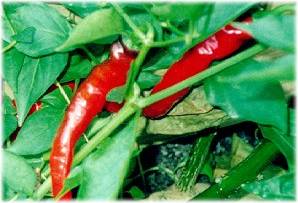|
Gardens Ablaze |
||
|
|
Cayenne |
|
|
Additional Cayenne Information
Medicinal Uses Site Map
Home |
 Cayenne
is an grown as an annual
in North America, but comes from Central and South America, where it is
a perennial.
Its flavor is pungent and hot. It is a shrub-like plant with dark
green leaves, and the fruits vary in color from green to red depending on
their maturity. The fruits can be used fresh, dried, or ground as
a spice. Paprika is the mildest form of this powerful plant. Harvest
the peppers when the fruit has turned uniformly bright red. Cut the
stems a half inch from the top of the pepper. String them up immediately
on a line to dry, or pull the entire plant and hang upside down in a well-ventilated
place. Once dry, the peppers can be ground in a food processor. Cayenne
is an grown as an annual
in North America, but comes from Central and South America, where it is
a perennial.
Its flavor is pungent and hot. It is a shrub-like plant with dark
green leaves, and the fruits vary in color from green to red depending on
their maturity. The fruits can be used fresh, dried, or ground as
a spice. Paprika is the mildest form of this powerful plant. Harvest
the peppers when the fruit has turned uniformly bright red. Cut the
stems a half inch from the top of the pepper. String them up immediately
on a line to dry, or pull the entire plant and hang upside down in a well-ventilated
place. Once dry, the peppers can be ground in a food processor.Cayenne can be used to spice up oils and vinegars and adds hot flavor to salsa, chili, dips, and tomato-based sauces. It can be added to barbeque sauces and scrambled eggs for a spicy treat. Pregnant or lactating women should avoid Cayenne. Mature Cayenne peppers are nutritional powerhouses. They are bursting with vitamins A and C, niacin, iron, and potassium. Grow Cayenne peppers in the same conditions as you would other peppers. Work the soil well and add organic material. Plant seed or starts in the spring after the ground has warmed. Peppers will make very little growth progress if the soil is too cold or too wet, and foliage will usually turn yellow and drop off. Provide a full sun situation and side dress with vegetable fertilizer once a month after the first peppers begin to appear on the plants. Be sure to mulch well, as Peppers like evenly moist, but not saturated soil.
Custom Search
|
|
|
Gardens Ablaze |
||